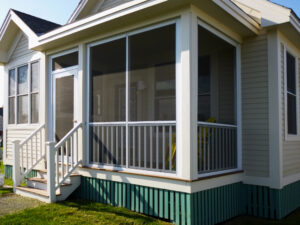Thinking about adding a three-season room to your home in Harford County? It’s an exciting upgrade—extra space, fresh air, and a perfect spot to relax without the bugs. But before you start dreaming about furniture layouts and ceiling fans, there’s a less glamorous (but absolutely critical) step to tackle: permits and zoning.
We get it. Permits and paperwork aren’t exactly what most homeowners look forward to. But skipping this step can lead to costly fines, forced tear-downs, or headaches when it’s time to sell your home. That’s why we always recommend working with a professional who knows the ins and outs of Harford County’s building process.
Still curious about what’s involved? Here’s a quick breakdown of what needs to happen behind the scenes before your three-season room can become a reality.
1. Know the Local Zoning Laws
Harford County has specific zoning regulations that dictate what you can build and where you can build it. This includes how close your structure can be to property lines, how tall it can be, and whether it’s allowed at all based on your zoning district (R1, AG, etc.).
A zoning review is always the first step. You’ll need to determine:
-
Your property’s zoning classification
-
Any setbacks or buffers required (especially near streams or wooded areas)
-
Whether your HOA has any restrictions beyond county code
Zoning rules vary even between neighboring towns like Bel Air and Street, so what’s okay in one area might be restricted in another.
2. Pull the Correct Building Permits
To legally build a three-season room in Harford County, you’ll need to submit a building permit application through the Department of Inspections, Licenses and Permits (DILP). Your permit will likely need to include:
-
Site plan with dimensions and distances to property lines
-
Construction drawings or blueprints
-
Structural details (foundation, walls, roofing)
Additional permits might be required for:
-
Electrical work (if you’re adding lighting or outlets)
-
HVAC modifications (if you’re connecting it to heating/cooling systems)
It’s important to note: If the space is going to be used more like a sunroom or four-season room, your project may be reviewed under stricter code requirements—including energy efficiency and insulation.
3. Be Ready for Inspections
Even after your permit is approved, you’re not in the clear just yet. Harford County requires inspections at different stages of the build—especially if there’s framing, electrical, or structural work involved.
Common inspections include:
-
Footing and foundation
-
Framing
-
Electrical rough-in/final
-
Final approval before use
Missing a required inspection can stall your project or require costly corrections.
4. HOA and Community Requirements
If you live in a neighborhood with a Homeowners Association, don’t forget about HOA approvals. These rules can cover design aesthetics, materials used, and how the structure fits into the neighborhood.
We’ve seen more than one project delayed by not getting HOA sign-off first, so it’s best to get their green light before submitting anything to the county.
Why It’s Worth Bringing in a Pro
Permitting isn’t just about checking boxes—it’s about avoiding costly mistakes and protecting your investment. When you work with a contractor who knows Harford County’s building codes inside and out, the process becomes faster, smoother, and far less stressful.
We handle:
-
The zoning research
-
Permit submissions
-
All communication with county departments
-
Scheduling inspections and ensuring compliance
You get to focus on designing a space you’ll love—without getting lost in paperwork or county code language.
Ready to Take the First Step?
If you’re considering a three-season room, let’s talk. We’ve helped Harford County homeowners navigate this process hundreds of times, and we’ll make sure your project is fully approved, up to code, and built to last.
Have questions about permits or what’s allowed on your property? Fill out our quote form and let us guide you through it. We’ll handle the red tape—so you can enjoy the view from your new favorite room.






